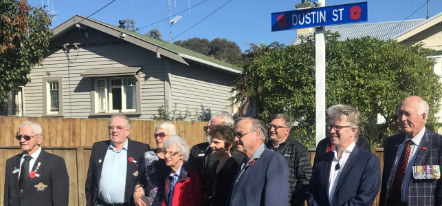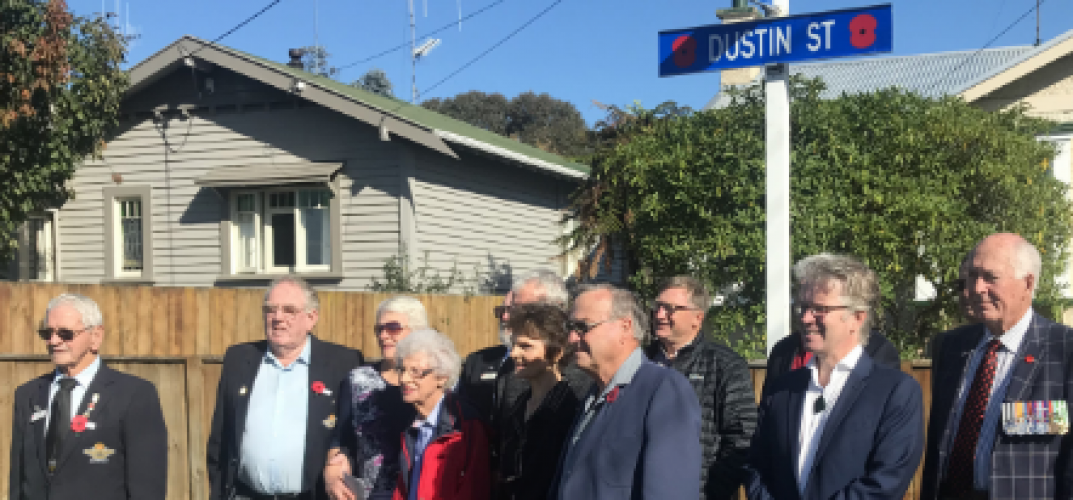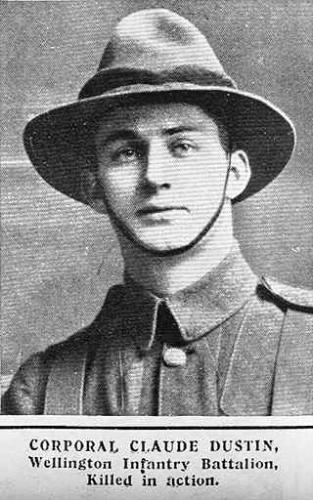Seven streets in Whanganui will have a permanent poppy icon added to their signage to recognise their affiliation to war history. The streets are Falkland Street and Kitchener Street (Whanganui East), Dustin Street, Gunn Street and Cavell Place (Gonville), Victory Place (Aramoho) and Somme Parade.
Street signs on Anzac Parade will also be updated to include the poppy in the next couple of months.
The street signs were installed on Monday, April 16 and a small unveiling ceremony was held on Tuesday, April 17 in Dustin Street. The project is a collaboration between the Wanganui RSA, the Poppy Places Trust and Whanganui District Council, which is funding the creation and installation of the signs. The Council’s General Manager – Property, Leighton Toy, worked with Kyle Dalton, Manager of the RSA, to get the street signs up.
“It was mentioned a while back that the Council was looking at installing street signs to reflect our connection with military history and we wanted to make it happen before Poppy Day,” says Mr Toy. “The RSA provided us with the history behind several Whanganui streets and we made the decision together about which signs to get made with the poppy emblem.
“There may be other streets with military connections which will be considered for inclusion of the poppy at a later date." Mr Dalton says the Wanganui RSA thought the concept of identifying street names and incorporating the poppy was “an excellent idea”. “The genesis of the project is that many of our street names and places are directly related to people and events from overseas military history, which is often known to only a small and shrinking number of our citizens. By using the poppy to mark these places, those that pass by the streets will see the symbol and be reminded of the ANZACs.”
Mr Dalton also says that launching the poppies on street signs project will be a fitting lead-in to Poppy Day which is on Friday, April 20.
Significance of the street names
Dustin Street was named after Claude Dustin, the first man from Gonville who was killed during WW1. Dustin was believed to have been killed on 27 April, 1915 in Gallipoli. He was the son of locally-renown caterer WS Dustin.
Gunn Street was named after William Gunn - the second man from Gonville to be killed in WW1, who lived in Heads Road. Gunn was killed in Gallipoli in May 1915. He also fought in the South African (Boer) war.
The decision to name Dustin Street and Gunn Street was made in June 1915 by the Gonville Town Board.
Cavell Place is named after British nurse Edith Louisa Cavell who helped save the lives of soldiers from both sides of the WW1 conflict and helped 200 allied soldiers escape from German-occupied Belgium. She was found guilty of treason and executed.
Falkland Street is named after the Battle of the Falkland Islands, the conflict between Britain and Germany, on 8 December, 1914. It was formerly called London, or Lundon Street.
Kitchener Street is named after Lord Walter Kitchener, Commander in Chief of the Allied Forces in WW1. Formerly, it was Paipai Street.
Victory Place was named in 1945, during VE Day victory celebrations for WW2.
Somme Parade was named after the Battle of the Somme, fought by British and French troops against Germany from July to November 1916. Previously it was Taranaki and Tongariro Quays.
Anzac Parade commemorates the landing at ‘Anzac Cove’ on the Gallipoli Peninsula on 25 April 1915 where many New Zealand and Australian troops died. Formerly Riverbank Road.






